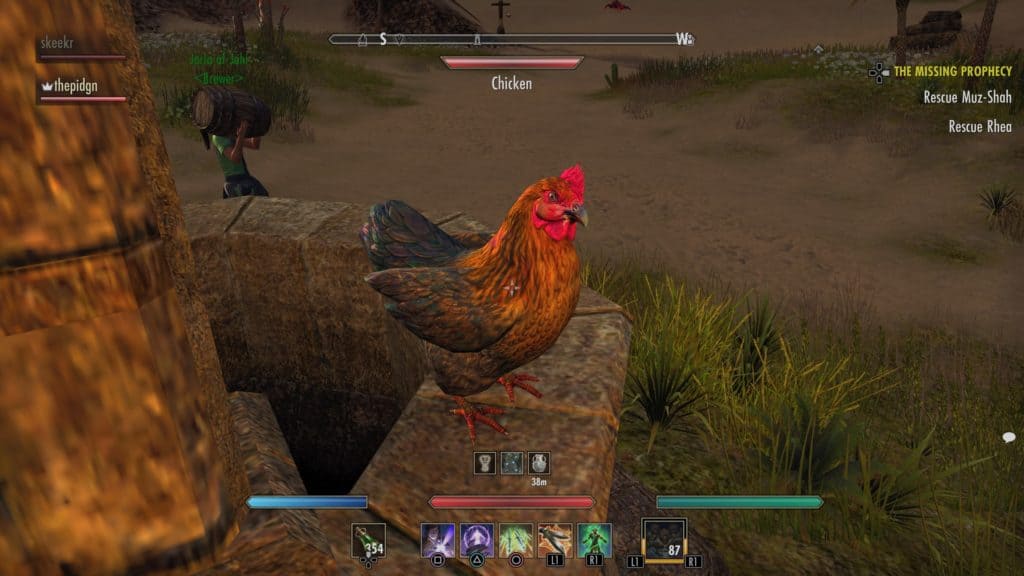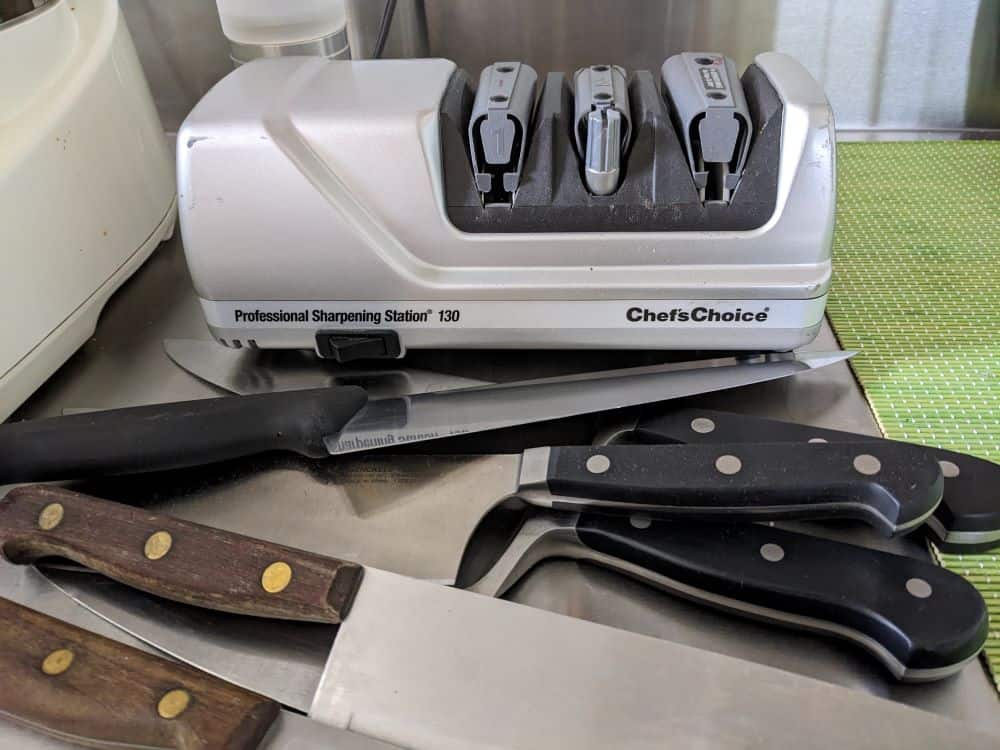It’s hard to believe that many gamers today—especially console gamers—have never experienced a massively multiplayer online roleplaying game. The labyrinthine systems and infinite grind at the core of The Elder Scrolls Online are familiar to anyone who cruised the pixelated forests of Everquest or World of Warcraft on a PC. These and other MMORPG arrangements—the repetitive quests, painful inventory management, hopeless loot drops, esoteric crafting and gear systems, and monthly subscription fees to go along with interminable pay-to-play expansions and DLC releases—seem bizarre and abhorrent by modern console-game standards, but through them game developers created worlds where players could spend years doing whatever they wish. And that is the raison d’être of MMOs – they’re game worlds.
Allow me to explain. In these games, the map is enormous. A player can walk uninterrupted for days or weeks and never see it all. Within this world thrives a harsh economy. Market prices fluctuate with demand from game trends and demographic shifts, and supply from recent mass events as well as “farmers” who eke out their in-game living collecting and selling weapons, gear, and materials. Some players are elevated above others, commanding armies and setting prices and policies at the helm of guilds or raid groups. You can’t imagine how these players obtained their incredible wealth and status, nor will you truly ever know. The years of their journey weren’t recorded.
And the populace? In many games, players are divine beings born to save the universe. In MMOs, players are insignificant worms. Their lives are controlled by the economy, the community, and developer gods who smite and bless on high. Stats on their gear, effects of their skills and potions, housing arrangements, and even quest and level requirements change when the herald cries, “The servers are being taken down for maintenance.”
Players are either mean as hell, stirred up because their in-game life sucks and they want to make sure things stay that way for everybody; or they’re generous to a fault, willing to do anything for anybody who asks, ready victims for scams in the service of compassion and philanthropy. Occasionally you connect with another player and become friends. In a word, MMOs are like life. Or, at least, a crude, ugly, and sometimes charming and charitable reflection of life and the world.
This is the source of MMOs’ incredible mass appeal and inclusivity. In most games, there’s no place for a player who can’t figure out a DPS rotation or take down the boss. There’s no fun for somebody who doesn’t work the gear system, learn his combos, and figure out how to win. Most games are like an obstacle course—MMOs are like a day around the house. Pass the time however you wish. Many players form and follow strict daily game habits. You can chat for hours. You can move furnishings around your virtual villa. You can study the fluctuations in the game economy. You can create a healer character, join a group, and acquire amazing rewards for sitting back and repeatedly pressing the same button without ever looking an enemy in his face.
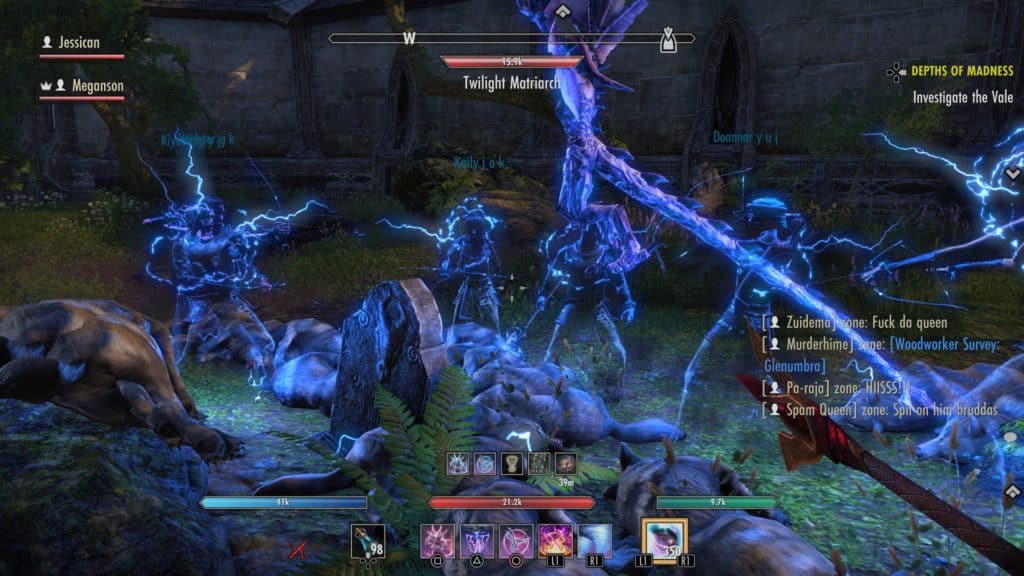
A reasonable MMO player might spend his entire game career collecting and trading cotton or silk, and it wouldn’t be a waste. We don’t say that a silk farmer is wasting his life—there’s a market for his goods! And just as silk farmers interact with a global economic system that is unfair, inhospitable, and downright nasty, MMORPGs give us a virtual shot at a similarly brutish system. We choose our path in the game, and then go about our tiny, insignificant chores and responsibilities each day within the system. And we like it, perhaps because virtual pain, loss, and joy compares favorably to real life.
Introducing Tamriel
If we take Guardians of the Galaxy as a modern portrayal of race and politics, it doesn’t do a bad job. It depicts a multiracial universe made of powerful, motivated individuals who make war or join forces according to their political or personal needs. Tamriel, the game world in The Elder Scrolls Online, is the opposite. It’s a brutal, antiquated feudal system where race is a biological fact that determines all. The game’s many races—dark elves, high elves, Bretons, Redguards, orcs, Kajiits, Bosmers, and more—each have assigned racial attribute passives. They are divided into three warring factions, each with its own territory and town centers.
When you create your character and choose his race, the game assigns you to that race’s faction, and then spits you out on that race’s soil, where you toil for that race’s leader until you achieve his or her nefarious purpose. If your chosen race belongs to the “Aldmeri Dominion,” your very first quest is to assist a Dominion spy with his machinations in service of the queen. Historical screeds help you identify with your character and alliance along the way. Cries of “Kill those lizard bastards!” and “Skooma-chugging Khajiits,” are common across zone chats. Much has been written already about ESO’s obviously racist “fantasy” ideation, and I think we can all agree that we’d rather be born into the world of Guardians of the Galaxy than Tamriel. A world where racial hatred is the primary theme is almost necessarily beholden to the injustices and evils that exist in the real world.
Every aspect of Tamriel is a crude reflection of some part of our own world, typically the economic and social constructs of feudal Europe. Guilds in ESO are treated as small medieval fiefdoms where leaders steward immense fortunes and manage large estates, funded primarily through the regular collection of taxes and dues from lower level members. Crafting is achieved largely through a patronage system whereby more experienced tradesmen are expected to bring young crafters under their tutelage by providing higher-level and difficult-to-acquire recipes or items for study. Even dungeon exploration is handled through membership in an association called the Undaunted. The Undaunted is nearly identical to pre-industrial era European exploration guilds like the Dutch East India Company, which controlled access to all known information regarding unexplored territories, in addition to outfitting explorers and providing cash prizes to its highest-performing members.
This confluence of systems makes it tough just to survive in Tamriel. An average denizen can end up with as many large debts and troublesome obligations as he can accumulate here on Earth. It’s easy to go broke. And like in the real world, if you stop playing for a month and neglect to pay your dues, debt collectors (in the form of guild leaders) will blow up your inbox with threats and demands for payment.
Introducing Cyrodiil
Nowhere is Tamriel crueler than in Cyrodiil, the open-world PvP zone in the center of the game world’s map. The three warring nations, separated by geography, philosophy, and racial hatred (mostly racial hatred), all have laid claim to this land. And we, the citizens of Tamriel, have been conscripted to fight in this war.
In many ways, Cyrodiil defies simple explanation. It is an enormous, open territory featuring a large-scale game of Risk—the goal is to take a castle, outpost, or farm in the enemy’s territory while defending your faction’s properties. The overall effect is magnificent. The unchanging map and mostly-unchanging player base provide a stable system in which to learn and grow. Unlike session-based PVP, in Cyrodiil, you always have the opportunity to try again, rectify your mistakes, even clear your name—often against the exact same players. You can defend (or persecute) the weak. You can grow stronger than your bully, and then find him and beat him up. You can look up the top players on the leaderboards, then locate and fight them as if you’re participating in the martial arts tournament in Dragon Ball.
The ESO alliance war is far more immersive than the war in Battlefield or Call of Duty. Its engagements, whether 1v1 or 30v1, are more intense and savage than any other content in ESO, or in any other PVP game the two of us have played. In fact, whenever we try a game with great combat we find ourselves longing for Cyrodiil’s format. For Honor, for example, would be wonderfully suited to a permanent map with real, memorable resources rather than session-based engagements.
Because the challenge of capturing an enemy castle in Cyrodiil is too great for one player alone, most flips are accomplished by enormous zergs (groups of players haphazardly banded together) or organized groups.
Solo players wander Cyrodiil as they would a desert. They do as they please. There’s no pressure to defend a certain castle. You won’t cause your alliance to lose by dying 500 times in a single evening and never once killing an enemy. If you spend eight hours holed up in a tower on a farm, nobody will fault you for it; and if you spend thousands of alliance points to buy and set up fifty siege engines, nobody will commend you. Play as you please—mind your own business. Time passes traveling on horseback from one location to another.
This quote from Jean Baudrillard’s America couldn’t apply better:
Everything is to be discovered, everything to be obliterated. Admittedly, there is the primal shock of the deserts and the dazzle of California, but when this is gone, the secondary brilliance of the journey begins, that of the excessive, pitiless distance, the infinity of anonymous faces and distances, or of certain miraculous geological formations, which ultimately testify to no human will, while keeping intact an image of upheaval. This form of travel admits of no exceptions: when it runs up against a known face, a familiar landscape, or some decipherable message, the spell is broken: the amnesic, ascetic, asymptotic charm of disappearance succumbs to affect and worldly semiology.
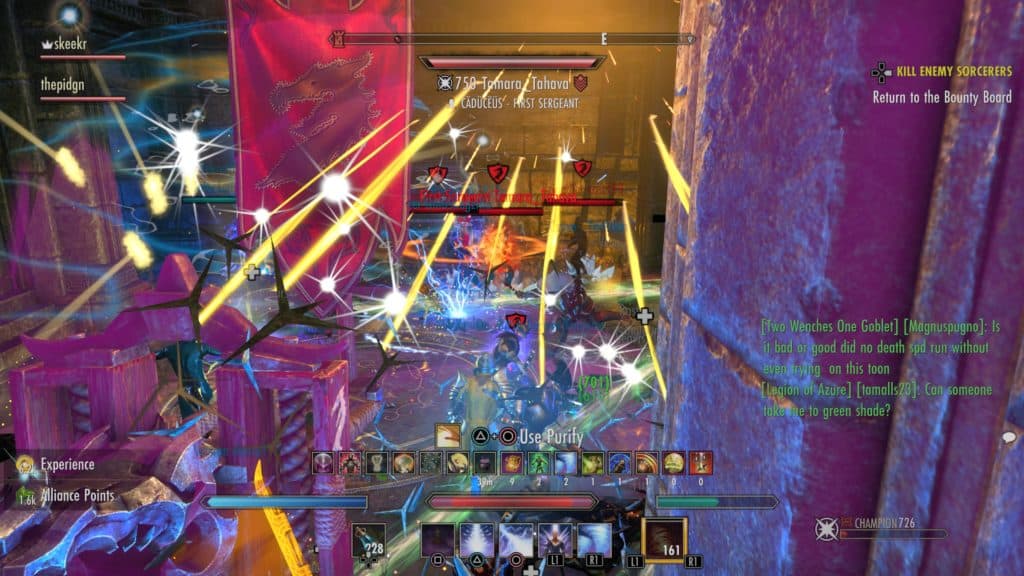
The zergs provide the primal shock and dazzle, their overpowering spewage of deadly animations flashing and pulsing as hundreds rush through castle doors and corridors. The secondary journey—the pitiless distance with anonymous faces—is the one that players must take on their journey to “git gud,” becoming machines of mass slaughter that consume countless others on their meandering, pointless journeys across the endless map. And the miraculous geological formations—those randomly generated map features, such as a boat overturned in the water or a ditch with a muddy creek near a chokepoint—regurgitate new forms of slaughter and nightly upheaval while players squirm across their pixelated features in elaborate dances meant to deceive.
And, of course, the broken spell—once you’ve killed enough players to become a known menace; once you’re recognized and always recognizing enemy players; once you’re receiving your own customized hate mails; the dream-like voyage across the desert crumbles. At that point, it’s hard to see Cyrodiil as anything but a toxic, degenerative cesspit.
The zone chat allows players to persist in this milieu. The closest real-life analogues are a public basketball court where people play pickup ball or a smoky, 1970s pool hall. People are there to play and compete, but the real draw is the persistent social interaction with semi-strangers. You can hop into Cyrodiil at any time of the day and find the same cast of characters. Some are your buddies, but others are low-down cheats and thugs. Many nameless faces are passing through, but you’re there because of the guys.
The Cyrodiil zone chat is more than just a chat room on the web. The logged-in members are sharing an experience on a grand scale, that is the war in Cyrodiil itself. The chat falls deathly silent during an intense battle that requires the players’ concentration, with the occasional order or command being sent by a group leader, and then explodes with jubilation after a decisive victory, where even the shyest and worst players let their voices be heard. During the hours of bitter defeat when another alliance dominates the map, the chat room reads like a lonely hearts club for the degenerate, where players console or insult each other, describe the quantity and quality of cannabis they’ve smoked, and threaten to leave ESO forever for the greener pastures of other games.
Our Cyrodiil Journey
Our journey into Cyrodiil began when we received a gracious, automatically generated invitation in ESO’s in-game mail. It was sent by our alliance general, one of the NPCs you find in Cyrodiil, and it implored us to fight the good fight for our people, the Elves, and our queen, Queen Ayrenn Arana Aldmeri. We had no idea what Cyrodiil was, or even how to travel there. Like all things in ESO, there’s little in-game information. The invitation sat in our inboxes for weeks. One day I decided that we may as well answer the bell.
Thus began our journey into one of the crueler circles of hell. Most people reading this will have a hard time understanding the enormity of the mistake that Genevieve and I, as new players, made by quietly venturing on our own into Cyrodiil. It wouldn’t be going too far to say that it’s a little bit like a pair of college freshmen touring Syria.
There are no cues for players who enter Cyrodiil. You’re simply dumped at a gate, where you can see NPC soldiers doing drills, rows of disused catapults and ballistae, and a few lonely merchants in huts. No fighting occurs at the gate—each alliance has its own starting point, a tiny piece of safe territory reserved for players entering and exiting the map. The first time we spawned there, we saw no one. Though a few players were typing in the zone chat, the gate and land surrounding it were empty.
The only thing was to venture forth. We mounted our ponies and took the first steps into Cyrodiil. We were greeted by open space. Endless meadows, hills, and roads far longer and emptier than any others we’d traversed in Tamriel. Our horses were slow. Playing PVE, we fast-traveled everywhere and never rode atop these ridiculous out-of-shape game creatures, our horses. We had played ESO for several months before we even acquired a horse, and we certainly hadn’t seen any reason to level-up its “speed.” Now we suffered. The speed of an unleveled horse in ESO is ever-so-slightly faster than walking. Cyrodiil is truly immense for a zone in a video game – players calculated that its physical size is comparable to Kazakhstan or Argentina. Genevieve complained that more than 40 minutes had passed, and all we’d done was move our characters forward.
Players in the zone chat were blustering about some recent losses the alliance had taken; discussing strategies to pump up our alliance’s numbers before the next evaluation period; or were complaining about the manners in which their characters had most recently died. We desperately pushed in our joysticks, spurring our horses onward. Where could we find these players and their great battles?
After more than an hour, we approached an enormous castle. An enemy, outlined in red, was patrolling its walls. We were ecstatic! Was this another player? Hacking with a sword, he charged toward us. We awkwardly dismounted, and in a faltering, jumbled frenzy, we disposed of him. Suddenly, two more appeared. Inspecting their name plates, we realized these were NPC guards—not enemy players—and that we’d started a fight on our own outside a heavily fortified enemy castle. We decided to flee before somebody noticed the commotion. At the very least, something happened after the agonizing time we’d spent on our horses.
While we meandered, taking back roads away from the enemy castle, my character suddenly died atop her pony. The damage was quick and quiet; I hadn’t noticed it. My death report revealed what had happened. A Nightblade, the assassin class in ESO, had put down my low-level Sorcerer with a single arrow. He had been cloaked, invisible to the two of us, and now he was cloaked again. Genevieve panicked, dismounted, and scurried off the road, but she too was cut down, felled in a flash by the same Nightblade’s poisoned blade.
We were heartbroken. We spent hours wandering on horseback, never so much as glimpsing a friendly player or PVP battle, and then somebody finished both of us in several seconds. The experience was disorienting and depressing. We left Cyrodiil, vowing never to return.
A short time later, the two of us received another in-game mail from our alliance general. “Rewards for the Worthy,” was its subject. It commended us for our efforts in Cyrodiil and included several gifts. Among them was a stack of transmutation crystals. We’d never before seen these precious crystals, which allow you to change the trait on a weapon or armor piece. Just as quickly as I’d vowed to never return to Cyrodiil, I vowed to acquire as many transmutation crystals as possible.
And so we began to visit Cyrodiil every day, just long enough to earn a stack of transmutation crystals. Eventually, we learned how to travel from the gate directly to a friendly castle. We maxed our horses’ speed. We figured out how to read the map and knew where conflicts would arise, where certain groups patrolled, and how the endless cycle of castles, farms, and outposts flipping and being flipped determined the night’s possibilities.
In our early days, we saw strange and fantastic things. We encountered unkillable tanks, guys whose builds negated all damage. These fun-loving enemies allowed us to whale on them with our weak, low-damage skills as long as we’d like, as if they were training dummies. We saw coordinated groups of players moving through castles in tandem, like segments of a centipede, firing off explosive “bombs” that instantly annihilated any enemy or group of enemies in their path. These spectacles fascinated us and drew us deeper into the world of ESO’s PVP—how were these players accomplishing these hilarious and deadly feats?
About a month after we started playing in Cyrodiil, both phenomenons—the tanks and the bombs—were nerfed. We were disappointed. These nerfs were supposed to help out low-level trash like us, who ostensibly had been the victims of these “broken” game mechanics. But to us, broken things added character. The bombing trains and unkillable tanks had already become beloved pillars of our Cyrodiil experience. No matter how many times we were bombed, we wanted to figure out how to beat the bomb—how to be better. These players exploiting the gear or skill systems added challenge, authority, and a level of cool. The tanks had been harmless enough, we thought. What the heck was ZeniMax’s problem?
In the meantime, we were growing more powerful. ESO combat has an unholy quantity of inputs: ten abilities, two ultimates, roll-dodge, block, sprint, heavy attack, light attack, and “synergies,” abilities which can be activated by pressing two buttons concurrently after a teammate has used an applicable skill. On top of all this, some builds require you to maintain different ‘states’ for your character, which open up yet more powers, loadouts, and combinations. Paired with the hundreds of diverse obtainable skills and thousands of gear sets with unique stats and bonuses, combat manners and methods are endless.
Using all of ESO’s 18 inputs in a rational, ordered manner against a boss requires only a modest amount of precision and situational awareness—using them in PVP requires complete knowledge of all the game’s class skills, their effects, and how to counter them. We learned to recognize the animations of the majority of the game’s skills; we knew which must be blocked, roll-dodged, or avoided entirely. We incorporated ‘weaving’ light attacks in tandem with skill inputs, a type of animation canceling that, with months of practice, delivers enormously more damage than skills alone. We mastered the management of our resources, learning to anticipate inflection points in combat where you could slow your output of skills and mana in order to get ahead on critical resources. We went so far as to purchase and learn to use Elite controllers—these conveyed such an advantage in commanding all of ESO’s inputs on console that it was inconceivable that most players played without them.
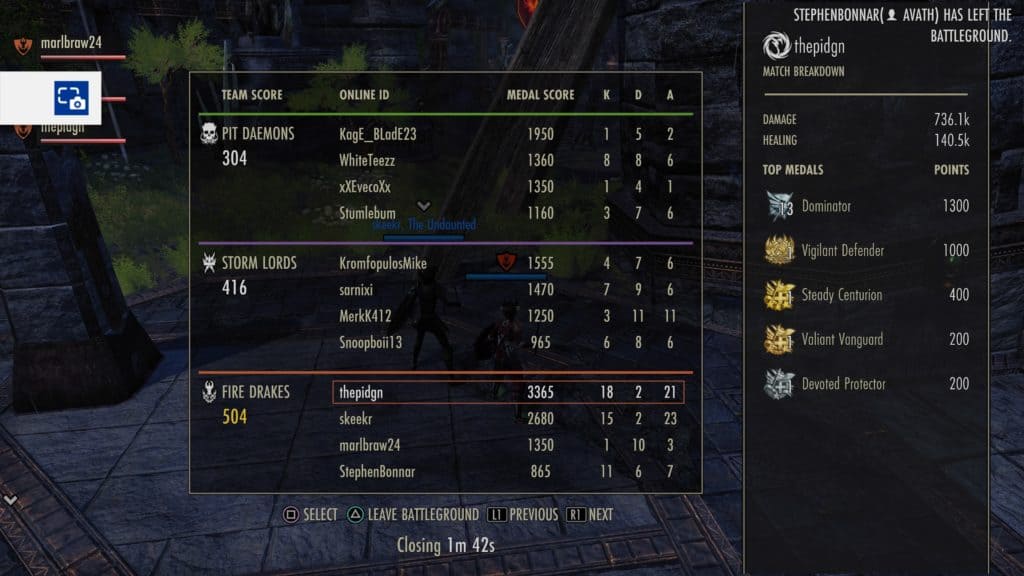
When we started, I was a magicka Sorcerer with a pet and slapdash PVE gear. Lobbing shitty little crystal orbs from the safety of the center of a zerg was the best I could do. Genevieve was a heavy armor magicka Dragonknight—she didn’t do much damage, but she wasn’t built to tank either. After learning more about the game’s mechanics, I changed my Sorcerer from magicka to stamina and put together a build that was near-impossible to kill, prevented the enemy from healing, and stacked every source of damage-over-time in the game. Genevieve focused on magicka regeneration to supply her Dragonknight’s arsenal of snare, root, and stun effects. She put on gear that passively shocked enemies every time she used a skill, and another set that raised her resistances the closer she was to death—she became a sturdy fountain of unavoidable damage.
Together we were a nightmare. Often players tried to gank Genevieve; she had outfitted her character in a Batwoman-like costume and she looked not only like a girl, but also like trash. When they judged her appearance and launched their ill-conceived gank attempts, they never suspected she was a Dragonknight, a tough-to-kill class, and even worse that she was geared out to survive almost anything. While an enemy player painstakingly discovered that she was hard as hell to kill (that gear raised her resistances the closer she was to death!) I quickly slaughtered them. When players focused on me and ignored Genevieve, they’d find themselves on the receiving end of electric shocks and a long series of annoying Dragonknight damage-over-time attacks that held enemies in place, alternately stunning and rooting opponents in an unlimited cycle.
Enemy players died so quickly from losing their ability to heal that it was hard to tell what had happened, at least that’s how Genevieve would describe the brutality of dying at my hands when we dueled each other. She was a nightmare to fight too, snaring me, grinding me down with damage over time, shocking the shit out of me any time I got near, and being almost impossible to finish off. The two of us with our hellish builds and heinous cooperation could take on opposing groups of six, eight, and sometimes ten and more. We could get the better of many of the more notable and prolific player-killers on the opposing alliances. Players grew to despise me; hate mail began to arrive. We made friends and developed favorite enemies, players whom we admired for their ability to kill us.
We were heroes! We rampaged across the map, clearing out tough player-farming groups that set up shop in outlying towers; arriving just in time to turn the tide of a castle defense in our alliance’s favor, and thwarting the attempts of our enemies to steal our alliance’s precious Elder Scrolls. We got to see more of the map than we dreamed existed. We climbed to the peak of the tallest mountain deep in enemy territory. We walked through the copses of pines outside the very gates of the Daggerfall Covenant and the Ebonheart Pact, and we slaughtered enemies as they attempted to venture forth. Once, on a slow night, we even intercepted an Elder Scroll, killing the enemies who held it, and carried it back to our home keep ourselves, a task usually reserved for groups of twenty to forty players.
In Cyrodiil, alliance points (or AP) are earned whenever you kill another player or participate in the assault or defense of a keep. The leaderboards, which display the top AP earners in descending order, are perhaps the most prominent feature of Cyrodiil. Playstation players do not receive kill/death ratios or summary reports at the end of a night in Cyrodiil. AP is the measuring stick that players must use to evaluate their performance. For true—that is, compulsive—Cyrodiil players, position on the leaderboards and rate of AP gain measure a player’s value and worth. Of course, if other players perceive that a certain top player spends the majority of his waking hours on the game, he’s seen as a degenerate and a tryhard.

During our heyday Genevieve became the number one Dragonknight on the leaderboards in our alliance. At some point, we were top five on our alliance’s leaderboard. On the overall leaderboard, we were closer to number twenty or thirty. We continued to clock in around top ten or top fifteen on our alliance’s leaderboard, and in the twenties or thirties on the overall leaderboard, for two or three months. Pretty good for a group of two.
Then we got bored. Or we became malaised. Perhaps, as Baudrilliard said, we had succumbed to affect and worldly semiology; the signs and symbols of the game—and emotional responses they elicited—had finally replaced our DPS rotations and the thrill of discovering a small country as the game experience. Conflict on certain parts of the map had become rote and irritating. Some of the notable toughs on the other alliances had brokered awkward treaties with John—these amounted to whiny, spiteful, blathering requests to be left unharmed, i.e. not killed, while farming our alliances’ lowbies. One of John’s favorite enemies began to simply flee at the sight of John’s character. Once we had an expectation of winning, losing—especially from sloppiness, exhaustion, lag, or glitches—was far more sinister. It was easy for us to blame each other and quarrel, and the endless rain of t-bags over our corpses from players pleased to have killed us salted our wounds. At any rate, some mixture of feelings made us abandon our winning characters and begin building new toons from scratch.

Over the course of the next few months, we created Nightblades, Dragonknights, Sorcerers, Wardens, and Templars. The process of leveling up a new character in ESO is long and tedious. Even with the power-leveling buffs, XP-grinding locations, and the benefit of completing all content in our two-man group, certain crucial skills and abilities took weeks to acquire. Farming gear for these new characters was an even tougher task, requiring dozens or hundreds of hours of grinding in veteran-difficulty dungeons, DLC maps, and specialized torture arenas that most players would never dream of entering. A typical engagement in ‘Veteran Dragonstar Arena’ lasts between four and seven grueling, high-stress hours and offers nothing more than a small chance—about 12%—at a useful item.
But we welcomed the respite from PVP. It no longer mattered how we spent our time; we had a hundred ideas to execute and ten thousand objectives to accomplish, everything from checking guild stores to activating waypoints on maps. Sometimes we entered Cyrodiil with these low-level characters and allowed ourselves to be farmed. We completed the build process for several new classes and managed to drag them back to some position on the leaderboard.
In the interest of full disclosure, I’ll point out that the new toons we built were all sets of twins, with the same gear, skills, and outfits for both of us. It was idiotic and insanely fun to act as identical automatons, lobbing the same combinations of skills in tandem at the same enemies. To anyone who died at the hands of this thick-witted trolling, we apologize.
It seemed that a new universe of fun was unlocking; in fact, we had reached the end of our rope. When ZeniMax nerfed the tanks, we couldn’t have known that we too were destined to feel the pains of ZeniMax’ heavy hand, destroying hundreds of hours of work we’d spent creating characters, grinding for gear, and obtaining resources to alter and improve gear. Within a month of working on a new character, my first and primary character, with her healing-prohibiting build, was nerfed to an unplayable, garbage state. I regretted not enjoying her while I could. And then our new mages, with whom we’d been enjoying success in Cyrodiil, were nerfed a month after they’d reached max level.
We couldn’t have known that ZeniMax’ heavy hand would only grow heavier, year over year, month over month, as it had since the beginning, until, at the time we stopped playing, ZeniMax had gone so far as to nerf the Nightblade’s fundamental skill: Incapacitating Strike. It was fitting that we stopped playing around the same time that the skill that had brutalized Genevieve during our first foray into Cyrodiil was finally deemed reprehensible. It had stopped being a threat to us long ago, as soon as we learned to recognize its sound and simply hold block.
Nerfs weren’t the reason we stopped playing. The joy of playing ESO truly died when Cyrodiil itself died. The game simply stopped working.
Crashes, Freezing, Lag, Glitches, and Bugs
The Somerset DLC and its accompanying patch introduced a litany of bugs to Cyrodiil. Castle walls at full health displayed as if they were demolished, allowing free and easy access to enemy players. Resurrected players became invisible and could cruise among enemies as ghosts, invisibly slaughtering as many as they’d like. But when I say Cyrodiil stopped working, I mean that nobody could play the game for more than a few minutes at a time. All players on all alliances froze and crashed every three to ten minutes. Relogging was like using a 3-inch net to catch a tetra in a 50-gallon aquarium. During the loading process, the game crashed again and again. In the zone chat, players would sardonically brag about spending more than an hour attempting to log in, and then, furious and disappointed, they’d log off for the night. If you were lucky enough to relog on your first try, the process took roughly five minutes. As soon as your toon appeared in Cyrodiil, you’d play for one to seven minutes, and then crash again.
The crashes were like a plague that struck down a virtual population. They weren’t related to the number of players participating in a battle—they happened randomly at any time. If you rode your horse across a meadow, you crashed. If you attempted to use a castle door, you crashed. If enemy players approached a castle and a skirmish began, all players crashed. Sometimes one entire faction would crash and the other would remain unharmed—this led to a senseless, randomized map where castles could be flipped by anyone who approached the castle in the moments after a mass crash or escaped the main crashing event by having crashed and relogged a minute before.
Let me set the scene of a battle typical of Cyrodiil at the time. An invading army of twenty Ebonheart Pact players approached Sejanus Outpost, a crucial strategic point between Ebonheart Pact and Aldmeri Dominion territory. There were only a handful of Aldmeri Dominion defenders at Sejanus. Probably we would have lost the battle and the outpost. We rushed across the battlements, but before so much as a single arrow flew, the entire invading army crashed and disappeared.
We, the awestruck defenders, investigated the meadow which a moment before had been filled with enemy players. Gradually the grass became populated with little creatures—dremora and goblins. These were the pets of the mages who had recently crashed. In ESO, summoned pets load into a map before their masters. Enemy mages were attempting to reload, and their pets beat them to the punch. We slaughtered each little goblin. Then, as their masters loaded into the game, as fast as their respective Internets would allow, we slaughtered them one by one. Thrilling PVP.
ZeniMax’ response to these crashes was to deny they were occurring. For weeks they ignored complaints, though they were pouring in from all platforms, XBox and PC included. Then they asked players to send video proof. Certainly the players were lying or exaggerating! Meanwhile they patched updates to the crown microtransaction store, improving the experience of players giving ZeniMax money. Cyrodiil rage became a tsunami. Around this time, there was even a thread on the Elder Scrolls forum from a guy on PC who figured out how to fix the issue—of course, only the most technically savvy users would be able to do this, and it was impossible to fix on consoles. ZeniMax did not acknowledge the fix, nor did they even seem to be aware of the valuable technical information relating to the crashes that a player had unearthed.
Finally, more than a month after the reports of crashes became truly widespread, ZeniMax vowed to send someone into the game on console to see what all the fuss was about. This revelation was astonishing. Nobody at the company ever set foot in console Cyrodiil!
The other thing that developers are seeing that many of you might not see is that their devs do not play the game. Sure, they may play it at work for their job, but they do not play it like we do, people who care enough to be on this reddit. How do we know this? Almost every dev has worked on two types of products, the ones they use and love, and the ones they get paid to work on and then clock out at 5. . . It pisses us off that a bunch of people are making this game who do not care about it the way we do.
This quote comes from Reddit user Undefined7196. He’s talking about Bethesda and Fallout 76, and his words apply equally well to Bethesda and ZeniMax’ treatment of ESO. You can read his full post here—take a look, it’s worth the read. He talks about unit testing and why it’s clear that Bethesda doesn’t do it. Their patches and new feature rollouts constantly break other things in F76. And in ESO. Just like how Cyrodiil broke at the Somerset launch.
“I have never worked at a place that is not an early stage startup, or known any developer that has, that is not forced to do unit testing. We all hate doing it, but we all appreciate that it is done. As to why Bethseda does not do unit testing, who knows. Someone in charge over there has a “test it in production” attitude,” Undefined7196 writes. (On a semi-related note, Genevieve and I were terrified to see the ZeniMax logo the first time we loaded Fallout 76. That logo alone fizzled any anticipation or optimism we had for the game. And they didn’t disappoint: F76 was perhaps even more disastrous than ESO.)
We never found out if the crashes were fixed because they continued so long that we had to stop playing. So did almost every other decent, self-respecting Cyrodiil player. During the two months that we continued to attempt to sign in, familiar names and faces vanished from every faction. Great players whom we had become accustomed to fighting with and against stopped playing the game.
Bethesda and ZeniMax challenge players to evaluate their self-worth and the worth of their time every time they sign in. Playing ESO is like being in an abusive relationship. You love the game, but it hurts you over and over. You expect a pleasant evening and bawdy intimacy; instead the game stomps your feelings, pisses you off, and pushes you away. How many times would you give a drug-addict cousin money? If you plugged a cord into an outlet and it didn’t work, how many times would you keep plugging it in before you gave up? Ten times? A hundred times? A thousand times? How stupid are you? How desperate are you? These are the questions that Bethesda and ZeniMax want their users to ask themselves.
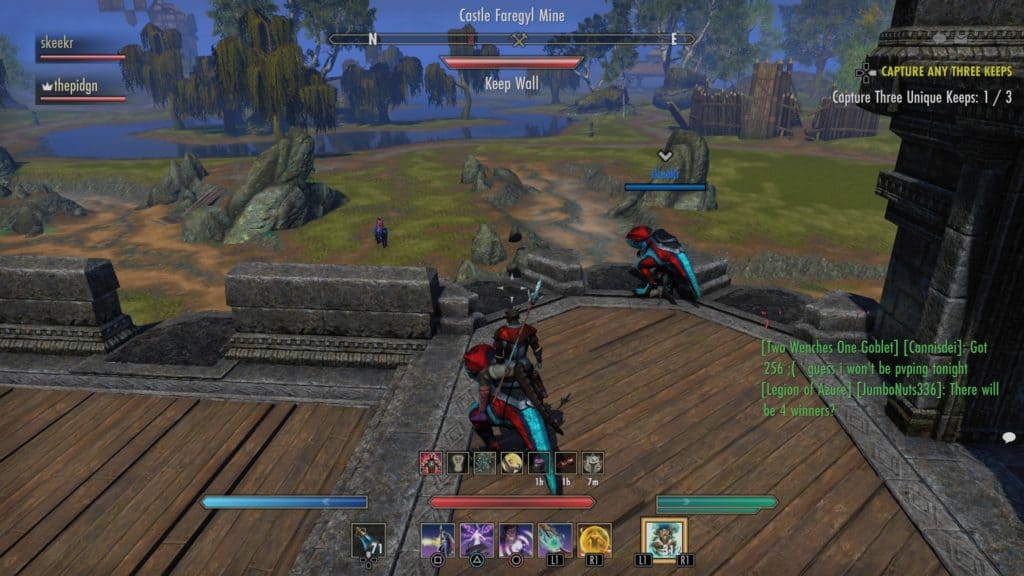
Cyrodiil crashes may have been the worst of ESO’s technical issues. Other bugs and performance issues were so enduring that they had become completely normalized in day-to-day gameplay. Join a group and your groupmates are invisible? Close the app and relog. Fighting a duel and your opponent is invisible? Close the app and relog. When you lagged out, you became a specter that could move unhindered through a frozen enemy zerg as long as you’d like before you close the app and relog. There were bugs in dungeons, hell, there were even bugs in skills! When John created a Dragonknight and tested its skills, he couldn’t figure out why he wasn’t getting a damage boost from a passive skill that buffed fire damage—turns out that passive never worked for all the years the game was available on console. ZeniMax fixed it in a patch sometime in 2017 or 2018. Only God knows what other passives or skills don’t work properly or at all. ZeniMax certainly doesn’t know.
Progression & Your Bank Account
Like all things in ESO, giving ZeniMax money is a long, drawn-out process. Ahead of each serious player lies a mountain of dollars he must climb. New players aren’t immediately seduced by cosmetics or locked out of fun without a monthly subscription. Only once they have invested substantial time in the game and understand its opaque, intricate workings do they begin to realize that things they took for granted are in fact paid account services, and that a subscription is crucial to day-to-day playability.
Let’s start with crafting. If you don’t buy ESO Plus, which costs $14.99 per month, kiss crafting goodbye. Plus grants unlimited storage for crafting materials. There are hundreds of different crafting materials across myriad crafting types. Furniture, potions, jewelry, food, drink, armor, and weapons all require different mats depending on class or level. Small crafting items flow endlessly into your inventory from every direction: boss and monster drops, crates and barrels at the side of the road, quest rewards, etc. Even if you vow not to hoard a single unique weapon or piece of gear, there still isn’t enough space across the game’s clunky inventory, bank, and chest storage systems to contain all its crafting materials. Some players resort to creating “mule” characters for the extra inventory slots. Good luck vowing not to craft at all—all rare and legendary resources for improving gear and weapons are crafting materials.
The ESO Plus “crafting bag” neatly ferrets everything away into organized, accessible categories. ZeniMax thereby associates a cognitive cost—constant, arduous inventory management—with simply playing the game. Then they provide a premium service that takes the pain away. Like a dog wearing a shock collar, we players will do anything to keep from being fried every few seconds.
Moreover, without Plus you won’t have access to DLC, which contains exclusive crafting locations for popular gear sets and jewelry. ZeniMax gives the happy option of buying these exclusive crafting tables in the Crown Store for an enormous one-time macrotransaction. Pay now, or pay later. Jewelry is one of the most important and difficult-to-obtain gear pieces in ESO—putting its crafting behind a paywall is cruel. If you refuse to craft yet want to play high-level PVP or PVE, you’ll be sucked deep into the game’s economy, blowing game gold on potions like a drug addict and spending hours sourcing and paying independent contractors to fulfill your elaborate crafting desires.
Another thing players take for granted is the ability to play PVP with their friends. Remember how we mentioned that in Cyrodiil, your alliance is determined by race? If you chose a High Elf and your buddy plays a Dark Elf, you’ll play in the Aldmeri Dominion while your friend becomes your enemy in the Ebonhart Pact. The ability to choose a new character’s alliance yourself is available for a $13.30 microtransaction in the “Crown Store.” (At the time of writing, the best deal for crowns on PS4 is 21,100 for $149.99, .007 cents per crown, and the “Adventurer Pack” costs 1,900 crowns, or about fifteen bucks.)
Oh, and those transmutation crystals we mentioned earlier—the handy items that allow you to change the trait on gear? ESO Plus increases your account capacity from 50 to 100. I can’t emphasize enough the importance of transmutation crystal storage when you’re both accumulating vast amounts of crystals from playing in Cyrodiil, and managing the gear and stats of several different characters within the game’s constantly-nerfing, constantly changing system.
So many nasty pitfalls of the intricate, opaque ESO system are smoothed-over for a fee in the crown store. We took our first steps into the store when John wanted to change his toon from a magic to a stamina class; this required changing to a race with stamina-buffing passives. The cost? Twenty-one dollars at the aforementioned “best deal” crown rate. Without buying a single cosmetic, costs quickly add up.
There are no quests in ESO that give crowns as a reward. You receive a token amount every time your Plus subscription renews. The store trafficked exclusively in marked money until sometime in 2017, when ZeniMax added daily rewards, which can include small amounts of crowns. It must have hit the insanely greedy marketing department like a ten ton bomb when they finally looked at some research and learned that giving players a bit of free gold makes them comfortable spending more in the store.
Meanwhile, thanks to ESO’s crown “gifting” system, players can trade crowns and scam each other. A quick Google search turns up hundreds of cases of trusting or naive players being scammed out of their paid-for crowns. ZeniMax takes the convenient stance that a crown is an in-game item and not real currency; which of course is true, ZeniMax is the only one holding your real U.S. dollar!
The insatiable hunger for crowns and bizarre player behavior surrounding them struck home when we created a guild. We needed a guild in order to attach a funny title placard to our characters’ names in Cyrodiil, and the game won’t grant a guild a placard until it has at least ten members. We paid some newbies game gold to join our guild. Immediately upon joining, a player started messaging John asking for crowns. John told him our credit cards were maxed out.
One can only imagine the heat Fortnite would take if its gold was tradable, and the harassing and scamming lengths kids would go to to get it. It’s an amazing game that enables scams and allows children to beg for game gold on console in 2019. Like so many things in ESO, the eminently fraudable, transferrable crown system is a relic of games-gone-by, early computer MMORPG games that were never meant for children’s eyes.
The main reason to resent ESO’s monthly subscription model is simple, though. ZeniMax does not use their players’ money for server maintenance or for quality-of-life improvements. Period. Something as humdrum as fixing the awkward console map navigation, which required zooming in and out using the triggers, would have made thousands of players happy. Instead, during the time we played, there were constant updates to the “outfit” system, allowing players to change their characters’ clothes colors and styles for a tidy pile of crowns. More important, as we’ve discussed at length, the game’s servers are and always have been a compost heap. In the time we played, the only appreciable improvement we saw was a fix for the way Alliance Points were calculated—players had been required to remain in the vicinity of a recently-flipped resource for up to 20 minutes in order to receive AP “credit” for their actions.
Conclusion
I often wonder what our ESO experience would have been like if we’d stuck to PVE. Some of our best memories of the game came from the grind. Making new characters and testing their skills by two-manning dungeons gave us hours of uninterrupted pleasure. I still fondly remember two-manning veteran Darkshade Caverns, one of the tougher veteran dungeons in the game, and the insane concentration and precision it required to take down the hellish jellyfish boss with just two Sorcerers.

And two-manning veteran Imperial City Prison twenty or thirty times, until we had collected enough Sheer Venom gear pieces to outfit two Nightblades, was pretty satisfying. When we were forced to join up with other players to complete PVE content, we generally had a great time. Perhaps doing trials with a great group of guys in an awesome guild (of which there are many in ESO) would be consistently rewarding and easier on the mood than playing in Cyrodiil. But trials never seemed like the right place for a husband-and-wife team who don’t like to get on the headset, and the time it took to find players, send invitations, and group up made our late-night gaming feel like playing administrative assistant. Plus, PVE just doesn’t offer the drama and thrill of PVP.
We fondly remember the truly singular events you’d get to witness from players sick of fighting each other. Two salty Sorcerers in Cyrodiil once challenged each other to a public duel. Both were considered the best in the business of Cyrodiil player-killing. To witness their shootout, a coterie of Cyrodiil players followed them to a lonely wayshrine in the Al Akir desert. One of the duelists arrived ten or twenty minutes late, and John knew the jig was up. His character’s health had increased by a whopping 50%—a bad change for PVP in general, but an enormous advantage in the context of a duel. That guy had spent those ten minutes altering his gear and respeccing his toon so that the outcome of the duel would barely be in question. A blistering Sorcerer showdown ensued. Damage shields were popped, and tiny staff orbs flew back and forth in an incredible display of button-smashing agility. The winner (the guy who took the time to change his gear) emerged triumphant, having defended his name and proved to everyone that he was the better mage. His opponent’s cries for a rematch fell on deaf ears. No other game we’ve played regularly included these kinds of funny, banal, and wildly entertaining dramas.
There are so many great and singular things about ESO. The stable map, stable player-base PVP format of Cyrodiil. The gameplay, with its mind-boggling gear, skill, build, and input possibilities. The insane diversity of play and potential for uninterrupted exploration and accumulation. That’s why it’s so frustrating to ESO players that the game overlords are inattentive and abusive. Sometimes a guy would sign into Cyrodiil and type, “Haven’t played in two years. Did they fix the game yet?” Everyone got the joke. If you sign in ten years from now, something vital about the game will still be busted. Whether it’s performance problems, nerfs, or the slow and steady siphoning of money from your bank account, Bethesda and ZeniMax will find a way to frustrate and enrage you, pissing on your time, devotion, and effort. If you get into ESO enough to love it, it certainly will break your heart, and it will probably break it more than once before you dump it.
Not Recommended
